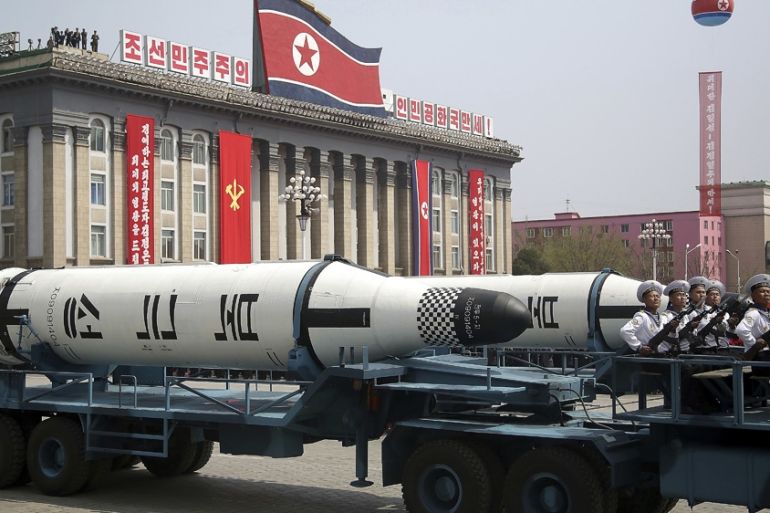North Korea’s suspected submarine missile ‘pushes the envelope’
If Pyongyang can launch missiles from submarines, threat will grow for Japan, South Korea and the US.

North Korea fired what may be a submarine-launched ballistic missile (SLBM) on Wednesday, which would be the first test in three years of what had been a relatively young but rapidly progressing programme to deliver nuclear weapons.
The launch comes hours after North Korea announced it would resume nuclear talks with the United States this weekend, potentially ending a months-long deadlock that followed a pledge by leader Kim Jong Un and President Donald Trump to make progress.
Keep reading
list of 4 itemsNorth Korea says Kim Jong Un oversaw test of new hypersonic weapon
North Korea claims progress in development of hypersonic missile
North Korea’s Kim oversees ‘super-large’ rocket launcher drills
The exact type of the missile and the launch platform remain unclear, but it appears to be a step that “pushes the envelope”, said Joshua Pollack, a leading expert on nuclear and missile proliferation and editor of Nonproliferation Review.
What happened?
A missile was launched from the sea soon after 7am on Wednesday (22:00 GMT on Tuesday) about 17km (10.5 miles) northeast of the coastal city of Wonsan, the site of one of North Korea’s military bases used for previous missile launches.
Japan initially said two missiles were launched but later clarified it was likely one projectile that went through stage separation. The projectile hit the waters in Japan’s Exclusive Economic Zone (EEZ), the Japanese government said.
South Korea‘s Defence Minister Jeong Kyeong-doo said an Aegis destroyer detected one missile launch, which flew 450km (280 miles) in a lofted trajectory 910km (565 miles) high.
It is unclear if the missile was launched from a submarine or a platform at sea.
What new threat does it potentially represent?
If the missile had been launched on a standard trajectory, the range would have been up to 1,900km (1,180 miles), which would put it in the medium-range missile class.
That missile would have all of South Korea and Japan within range. A launch from a submarine deployed in the surrounding waters would pose greater difficulty for their missile defence.
The threat of a submarine-launched ballistic missile grows exponentially with the range of the submarine. North Korea’s existing Romeo-class submarines, which were built in the 1990s, are believed to have a range of about 7,000km (4,350 miles), potentially making a one-way trip to near Hawaii possible.
But they are diesel-electric powered and very noisy, making them highly vulnerable to detection, especially by US forces with their decades of experience tracking Soviet submarines.
What is the progress of the SLBM programme?
North Korea began testing SLBMs in 2015 and conducted four submarine launches by August 2016, when a two-stage solid-fuel Pukguksong missile flew about 500km (310 miles) on a lofted trajectory. That test was considered a success.
There have been no known tests since then to suggest Pyongyang has made further progress in developing an SLBM of intermediate or long ranges.

Those previous launches were conducted near the port city of Sinpo, about 110km (68 km) from Wonsan and home to many of North Korea’s fleet of submarines, believed to be one of the world’s largest.
Despite the size of the fleet, most of the vessels are believed to be small or vintage Soviet-era models and only one is believed to be an experimental submarine capable of carrying a ballistic missile.
North Korea said in July leader Kim inspected a large, newly built submarine and that its operational deployment was near.
Analysts said photos released on North Korea’s state media suggested the vessel could be a modified Romeo-class type with an enlarged hull, not the larger submarine that satellite images have suggested was being built at the Sinpo shipyard.
Second-strike capability?
Submarine-launched ballistic missiles are considered key to delivering a second-strike capability that can be used to retaliate against a nuclear attack.
To be assured of the capability, the submarine must not only have the ability to launch a nuclear ballistic missile but also the endurance to sail within range of the enemy.
|
|
Military analysts are sceptical North Korea’s submarine programme has reached the level of technical sophistication to achieve a second-strike capability.
Other recent missile tests
North Korea has conducted nine launches since Kim met Trump at the Demilitarized Zone (DMZ) inter-Korean border on June 30 and pledged to resume nuclear talks.
All but the one on Wednesday has been short-range missiles and rockets that would be a fast and effective way to attack South Korean and US forces stationed there.
Before Kim entered an unofficial moratorium on missile and nuclear tests to engage in dialogue with Trump, Pyongyang test-fired an intercontinental ballistic missile (ICBM) in November 2017.
If launched on a standard trajectory, that missile would have had a range of up to 13,000km (8,078 miles), putting the mainland US within range of a strike.
But experts are doubtful North Korea has mastered the technology to build a nuclear warhead small enough to be mounted on a missile that can withstand re-entry to the atmosphere and to guide it with precision to hit the target.